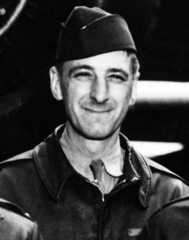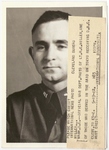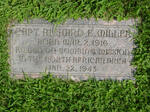Miller
Richard Ewing Miller, 0-432352, Captain
Bombardier Crew 2
Born March 2, 1916, Fort Wayne, Indiana
Killed in Action, January 22, 1943 from wounds received in action over North Africa
Two years college. Enlisted as a Flying Cadet February 25, 1939 at Fort Benjamin, Harrison, Indiana. Eliminated from pilot training April 1939. Re-enlisted as Flying Cadet for Bombardier training, May 29, 1941. Rated as bombardier and commissioned Second Lieutenant, December 16, 1941. After Tokyo Raid was assigned to 319th Bomb Group and served in North Africa. Died January 22, 1943 of wounds received in action while on a bombing mission. Decorations include Silver Star, Distinguished Flying Cross, Purple Heart, Air Medal with 1 Oak Leaf Cluster, and the Chinese Army, Navy, and Air Corps Medal, Class A, 1st Grade.
Tags: Crew 2Frank Gray - Fort Wayne journal Gazette
Published: March 16, 2008 6:00 a.m.
Star honoring local Doolittle Raider rises in mystery
In the early years of World War II, one Fort Wayne native quickly attained hero status.
His name was Richard E. Miller, a 1933 Central High School graduate, a captain in the Army Air Corps and a bombardier.
What set Miller apart was that four months after the war began, he was made one of Doolittle’s Raiders.
For those who haven’t heard of him, James Doolittle was a famous flier who had flown in World War I, held a Ph.D. and once held the air speed record for land-based airplanes.
In the early days of the war, the U.S. was getting beaten up bad. Its Pacific fleet was ravaged by the attack on Pearl Harbor and huge numbers of American soldiers were surrendering in the Pacific. Japan, meanwhile, which dominated much of the Pacific, seemed well protected by thousands of miles of ocean, out of reach of the Americans.
So Doolittle, who had rejoined the Army as a lieutenant colonel, came up with a plan to put bombers on an aircraft carrier, steam to within a few hundred miles of Japan and bomb Tokyo. The idea was to instill fear in the Japanese, prompt the Japanese to pull some of their forces back home to protect the home island and give Americans a big morale boost.
The raid took place April 18, 1942. Sixteen planes took off and struck military targets in Tokyo. In the end, all 16 of the planes crashed, either in China or in the sea. Of the 80 men on the raid, 11 were either killed or captured.
The 69 who survived, including Miller, then a lieutenant and the bombardier on plane No. 2, became instant heroes. Doolittle got the Medal of Honor. The rest were awarded the Distinguished Flying Cross. Some came back to the U.S. to help promote the sale of war bonds. The others, including Miller, kept fighting.
Only nine months later, on Jan. 22, 1943, Miller died from wounds received during a bombing raid in North Africa. His death was front-page news in Fort Wayne.
But the Doolittle raid was 65 years ago. Today, many people have never heard of Doolittle. A facility at Grissom Air Reserve Base in Bunker Hill is named after him, but it’s a good bet practically no one knows a Fort Wayne native was involved in the famous raid. It’s old news.
At least it was until a girl named Tina Heth was helping her grandfather clear out some old steps at his house in Antler, N.D., not too long ago. In the fill under the steps, Heth found a large copper star, about eight inches wide, and on the star was engraved the name Richard E. Miller, Captain, U.S. Army Air Corps, Member of the Famed Doolittle Raid on Tokyo, April 18, 1942.
Heth started doing some research and learned that Miller had been killed later in the war and that he was buried in Lindenwood Cemetery.
Heth’s aunt, Lavonne Heth, who lives in Kansas, did send along a picture of the star, but it’s out of focus, and it’s impossible to read the inscription in the photo.
Ideally, Heth said, her niece would like to find a member of Miller’s family to give the star to. But Miller’s parents have long since died, and though he had a brother, Thomas B., and sister, Georgianna, it isn’t clear whether they are still alive, and if they are, whether they are still in the Fort Wayne area or whether either had children.
The biggest puzzle, though, is where this copper star came from. Was it part of a memorial, and if it was, where was the memorial? Was it once on Miller’s grave and was it stolen? If it was, how in the world did it end up mixed in with a bunch of rubble under the steps of a house in Antler, N.D., not far from the Canadian border?
Frank Gray has held positions as a reporter and editor at The Journal Gazette since 1982, and has been writing a column on local issues since 1998. His column is published Sunday, Tuesday and Thursday. He can be reached by phone at 461-8376; by fax at 461-8893; or e-mail at fgray@jg.net .


